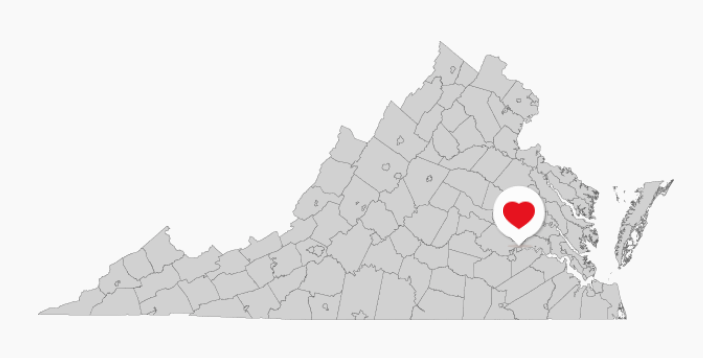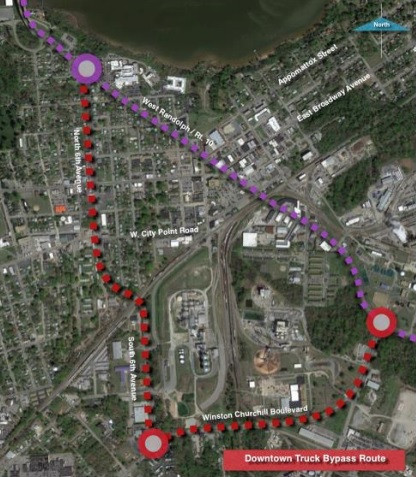Hopewell, VA’s complete streets overhaul shows small towns can be urbanist too

Hopewell, Virginia's famous H. Image by the author.
The successes and setbacks of creating safer streetscapes in big cities dominate our imagination, but many corners of small town America are quietly undergoing a complete streets transformation as well. The compact street grids of smaller cities like Hopewell, Virginia that developed before the advent of the automobile represent low-hanging fruit in the fight for safer, healthier, and more sustainable communities.
The City Council passed the Healthy Eating, Active Living (HEAL) resolution in 2015 in hopes of boosting the health of its 22,000 residents by providing them access to outdoor recreation and nutritious food. A new community food pantry and a monthly farmer’s market at Guncotton—a local nonprofit coffee shop—have slowly begun to shift the city’s food culture. However, Hopewell still ranks 127 out of 133 Virginia localities on health outcomes, according to the Robert Wood Johnson Foundation.
Hopewell, Virginia is located 24 miles southeast of Richmond. Image by City of Hopewell.
Where Hopewell has raced ahead has been in access to outdoor recreation. In the last two years alone, Hopewell has renovated four parks and playgrounds, built a new waterfront riverwalk, and adopted a comprehensive plan with miles of new biking and walking facilities. The city’s streetscape improvements have earned it a designation as a HEAL “platinum standard community” according to Aaron Reidmiller, Hopewell’s Director of Parks & Recreation.
Hopewell's riverwalk. Image by City of Hopewell used with permission.
From complete Street to Main Street
Two trainings with the National Complete Streets Coalition in 2016 and 2017 at Hopewell’s iconic Beacon Theatre brought together members of the City Council, the Crater Health District, the Cameron Foundation, the Department of Parks & Recreation, and the Division of Planning & Zoning.
The final draft of the city’s resulting complete streets policy is still underway, but Hopewell’s Director of Development Tevya Griffin has observed a marked shift to prioritize projects that emphasize recreation, mobility, and active lifestyles. Griffin says much of her work today focuses on “creating active connections between schools, the residential core, and the commercial downtown.”
The city added better sidewalks, pedestrian signals, and curb cuts to the 21st & W Broadway intersection. Image by City of Hopewell used with permission.
View of 21st & W Broadway. Image by City of Hopewell used with permission.
That emphasis on connecting residential with commercial has paid off according to Evan Kaufman, Executive Director of the Hopewell Downtown Partnership.
“We’re seeing a shift in the economics of our downtown towards a more pedestrian environment, and that growth is spreading out from Broadway to other parts of the city. The downtown has been a focus of redevelopment for a long time, but it took these initial streetscape projects to really transform the place,” Kaufman said. “Complete streets set the stage for our Main Street program to revitalize the corridor with new businesses and increased foot traffic.”
In the first two years after City Council made fostering active lifestyles the centerpiece of all new capital improvement, Hopewell’s downtown witnessed the creation of 25 new businesses and over 70 new jobs. Just this year alone, Kaufman has recorded 10 new businesses open downtown.
“Hopewell is one of those cities in which 10 years ago not many people had much hope for the future, but following Main Street and complete streets principles have changed the city in a way few people thought possible. Changing the highway feel of our main roads to a more walkable, bikeable space is making Hopewell into a model for other communities across the Commonwealth looking for growth,” said Kaufman.
The complete streets mission continues to grow
Thanks to funding from the Virginia Department of Transportation’s (VDOT) Transportation Alternatives Program, that transformation is likely to continue. A slate of complete streets projects are on track to be finished within the next two years.
Proposed bike improvements. Image by City of Hopewell.
Over the next six months, Hopewell plans to wrap up the design phase of new bike lanes along Appomattox Street between Hopewell’s downtown and City Point. Combined with its popular multimodal riverwalk to the City Marina, Hopewell is on track to be the first locality in the Gateway Region to complete its section of the Appomattox River Trail.
Hopewell’s complete streets coup de grâce will be a separated multimodal path along Route 10, the town’s main road. In an 80-20 shared funding agreement with VDOT, the City Council put forward the money required to shift truck traffic to an alternate route in order to redesign Hopewell’s John Randolph Corridor.
Route 10, and an alternative route for trucks. Image by City of Hopewell.
By swapping out a vehicle lane for a separated path, city officials hope to boost multimodal mobility and reunite Hopewell’s downtown core. Thanks to Bike Walk RVA’s assistance as a pro bono consultant, the project is already in its scoping and design phase, and Route 10’s rebirth should be completed in June of 2021.
With intersection improvements, bike lanes, and pedestrian facilities popping up all over the city, it’s hard not to notice the excitement around Hopewell’s complete streets transformation. City Councilor Johnny Partin of Ward 3 sees such multimodal changes as key to the future of Hopewell.
“I’m constantly seeing an increase in the number of people using these facilities and spending more time making this city feel like a community. These types of investments are appealing to a younger generation, and they are essential to making sure everyone can enjoy our streets in safety,” said Partin.
By emphasizing the health and safety of residents, Hopewell’s leaders have put complete streets at the center of the city’s transformation.
“We’re focused on making Hopewell healthier by giving people more suitable lanes and roads to stay active,” said Partin. “We’re making good strides to increase our investments in neighborhood infrastructure, and these changes are great for all our residents and for the city overall.”
